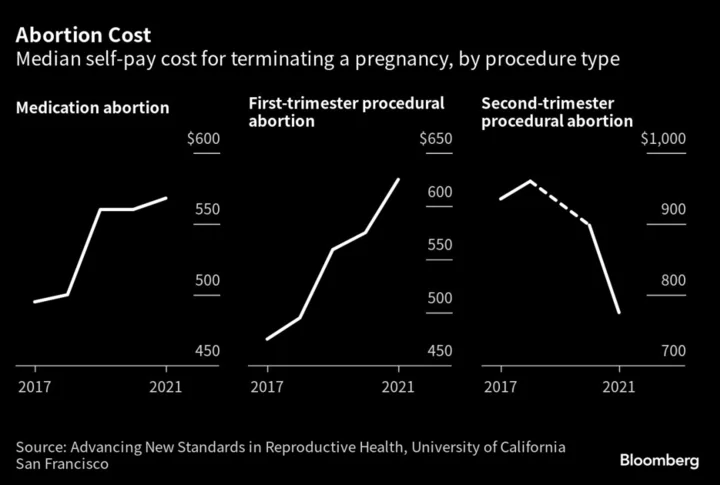While the long-term consequences of the end of Roe v. Wade could take years to tally, one outcome is already clear: a year after the Supreme Court ended the constitutional right to abortion, the costs associated with ending a pregnancy have soared.The Brigid Alliance, which provides logistical support to people seeking abortion care, estimates that the average cost of traveling for care has increased 41% since the first half of 2022, when it was just over $1,000. The average spend for patients that need to fly has jumped 17% to $994; while a hotel stay — usually three nights — is up 29% to $919, according to the group.
Though inflation accounts for some of the increase, state-by-state abortion bans mean people live an average of 275 miles further from a clinic than they did a year ago, according to Caitlin Myers, a researcher at Middlebury College. In Texas, the average drive to a clinic increased to 499 miles in March from 43 miles a year earlier, adding up to about $131 extra in gas for a round trip.
At another logistical abortion fund — the Midwest Access Coalition — the average cost per patient covered is now about $1,200, roughly double what it was before the ruling, said Marisa Falcon, executive director of Apiary for Practical Support, a network of groups that provide logistical assistance for abortion care.
“There used to be a balancing act between people who need to travel very far, and those who just need a little gas money,” Falcon said. “Now, everybody needs to travel a longer distance.”
More than a third of patients in 2022 had to travel out of state due to restrictions where they live, up from 24% the year before, according to the Women’s Reproductive Rights Assistance Project, a non-profit that provides financial assistance for abortions.
That puts enormous pressure on patients and the organizations that help them get to their care.
From July 2022 to May 2023, the National Abortion Federation, which runs a hotline for patients seeking care, helped pay for 1,090 hotel rooms, a 195% increase from the same period a year ago. The group helped fund 982 trips by plane, train or bus, up from 293 the year before.
In addition to travel, mandatory wait times in restrictive states mean patients need to take more time away from work — and child care — than when Roe was the law of the land. In Utah and North Carolina, for example, someone seeking an abortion must wait 72 hours between an initial consultation and receiving care. Nearly 60% of those ending a pregnancy already have children, and about half live at or below the poverty line.
Workers in the US also aren’t guaranteed paid leave, with many patients losing out on wages if they skip work.
“It’s not just the financial burden, it’s the psychological burden, it’s the stress involved,” said Sylvia Ghazarian, WRRAP’s executive director. “It’s not knowing that you’re going to have a job when you come back because you have to take time off work. It’s people having to sacrifice their basic necessities in order to find a way to pay for their abortion care.”
The group has increasingly been funding terminations via pills — known as medication abortions — which can be more affordable and less invasive than in-clinic care. The cost of ending a pregnancy via pill can be as low as $150, depending on if a patient can use telemedicine and get the medication mailed in their state, Ghazarian said. In 2022, 69% of the patients that WRRAP assisted used medication to end a pregnancy, up from 35% the year before.
The fate of mifepristone, also known as the abortion pill, is in limbo due to legal challenges. Another drug, misoprostol, which is used in combination with mifepristone in most terminations in the US, can safely be used on its own to end pregnancies, though it’s less effective. Misoprostol, primarily an ulcer medication that is more widely available, can cost less than a dollar.
Even ahead of the Dobbs decision, abortion costs had been on the rise as restrictions and rising costs forced facilities to close. The median out-of-pocket cost for medication abortion in 2021 was $568, up from $495 in 2017, according to researchers at the University of California San Francisco. The cost of first-trimester procedural abortions in 2021 was $625, a 32% increase from four years before.
There’s so far been little new research on the exact economic impact of the Dobbs decision, though earlier studies showed that prior abortion restrictions depressed women’s wages and labor force participation. Before last June, the Institute for Women’s Policy Research estimated that state-level abortion restrictions cost state economies $105 billion per year.
The costs for those who continued pregnancies will also take longer to estimate. There were almost 26,000 fewer abortions from July 2022 to March 2023 compared to the previous monthly averages from April and May 2022, according to estimates from the Society for Family Planning. Out-of-pocket health care costs associated with pregnancy and childbirth average $2,854, according to the Kaiser Family Foundation. Across the US, on average, it costs a middle-class family $310,605 to raise a child — up 9% from half a decade ago.

